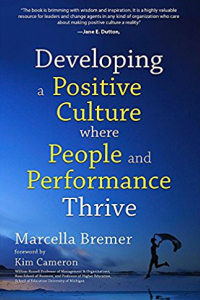Preview Thursday: Developing a Positive Culture Where People and Performance Thrive

The following is an excerpt from Chapter 2 of Developing a Positive Culture Where People and Performance Thrive
 Proof for the Positive
Proof for the Positive
Let’s see why a positive culture is vital to thriving organizations. The research evidence is compelling and exciting. Maybe some of these findings evoke a “duh” because they resonate with what you intuitively know. Nevertheless, for the skeptics out there, Kim Cameron collected proof that positivity pays off.
Why is positivity important for organizations? The short explanation is that when people feel good and positive, they will perform better. Feeling good boosts confidence, creativity and an optimistic outlook if something goes wrong nevertheless. Positive feelings enhance relationships and communication as well. You probably recognize this. When you feel good, you think you can take on the world. But have you ever delivered your best when you felt irritated, insecure, pressed, or scared, angry or worn out?
Barbara Frederickson described the effects of positive emotions. It “broadens people’s thought-action repertoires and builds their enduring personal resources” (Frederickson, 2003). Negative emotions narrow your repertory and diminish your coping abilities. A positive climate at work will “broaden and build” your organization because it makes people more creative, resilient, and innovative.
How and when have you experienced the broaden-and-build phenomenon of positivity?
How does “negative” harm performance?
By contrast, when we feel bad, negative, stressed out and exhausted we won’t perform well. The amygdala in our brains continuously scans the environment for potential dangers, like a smoke detector.” It is always on and stimulates the injection of hormones for fight and flight. Its basic question is: Will this threat eat me, or can I eat it? (Goleman, 2007).”
If we assess something as a threat, we will focus on it which narrows our scope, creativity, and ability to think of creative solutions. Our normal peripheral vision becomes reduced.
Stress creates tunnel vision literally and makes us vulnerable to judgment errors, jumping to conclusions, getting defensive, closing ourselves off, and worse.
As we have seen in Chapter 1, behaviors are easily copied. Moreover, moods are contagious because people mimic each other’s facial expressions without even being aware. This is a way for our mirror neurons to experience what the other is feeling, so we can better detect what is happening around us. But mimicking a negative expression will make you feel the same and that’s how moods subliminally spread in a team.
Some theorists even say that we affect people at least three levels out beyond ourselves. Imagine what happens in a toxic workplace and how that affects everyone at work and at home. I’ve experienced this as a consultant when I felt depleted after a session with a discouraged executive team of a division suffering under their headquarters abroad. I empathized too much and picked up on their mood, which left me discouraged and exhausted.
Fortunately, the effect can also be reversed as research shows that working in the vicinity of a positive leader, makes you positive (Goleman, Biyatzis, McKee, 2004).
In spite of the evidence that people and performance thrive in a positive organization, the majority of organizations still operates from the "mechanistic mindset" that manages people like human resources.
Executives prefer to control employees to deliver the highest possible output in the short term.
Emotions are judged and dismissed as soft. Well-being is nice when you’re at home, but at work, you need to be rational and tough. The workplace revolves around efficiency and competition. The focus is on fixing problems and going back to normal, which does not inspire to extraordinary performance.
How does your organization think and act?
Kim Cameron told me that his positive research evolved from studying the phenomena of downsizing: “Almost all of the downsizing organizations deteriorate in performance. This happens because conflict goes up, and morale, trust, and innovation go down. But 10-15% of organizations flourish after downsizing because of organizational virtuousness. They implemented practices like forgiveness, compassion, gratitude, and integrity. I found that those organizations were more optimistic looking at the future. They forgave the pain that was inflicted through the downsizing, instead of holding grudges and dwelling on the pain.
The evidence over the last ten years is clear: if you implement virtuousness in organizations, performance goes up, customer satisfaction goes up, everything gets better.”

What if you worked in a positive workplace? You and your team would engage (more), innovate, contribute, and give it your best! The world would look different if we all did. Positive organizations are agile, more innovative, competitive, collaborative and productive.
However, in over 20 years of consulting, I saw how many clients experienced the opposite. Even managers told me they couldn’t change their dreadful workdays! That’s why I wrote my new book and launched the Positive Culture Academy, in addition to offering the OCAI culture survey online.
Marcella Bremer is an author, and culture & change consultant. She helps leaders, middle managers, supervisors, HR professionals, OD consultants, and employees to develop a positive culture at work. She believes we can thrive and change our workplaces and the world.






